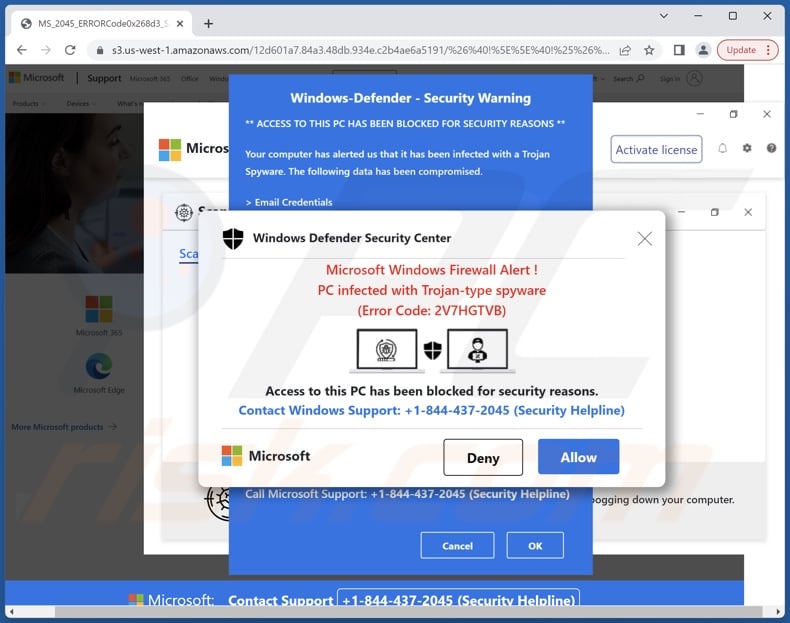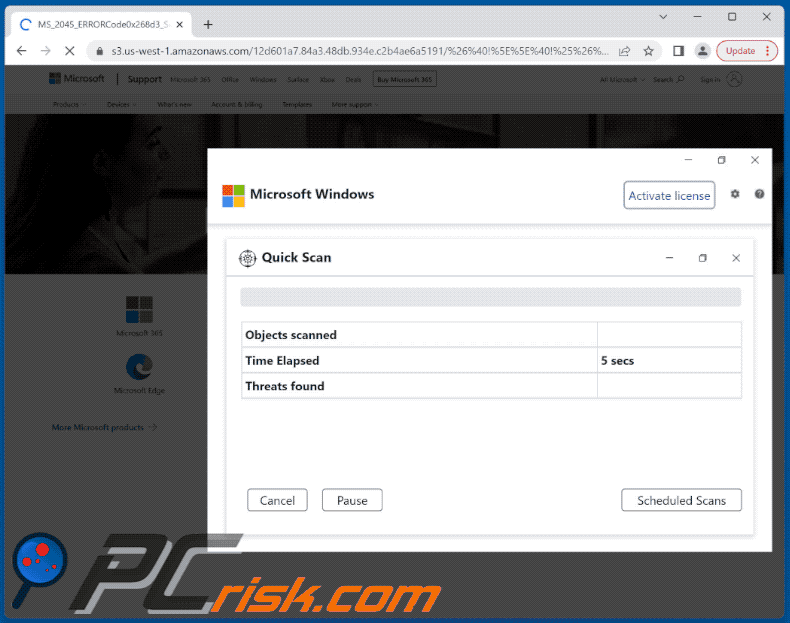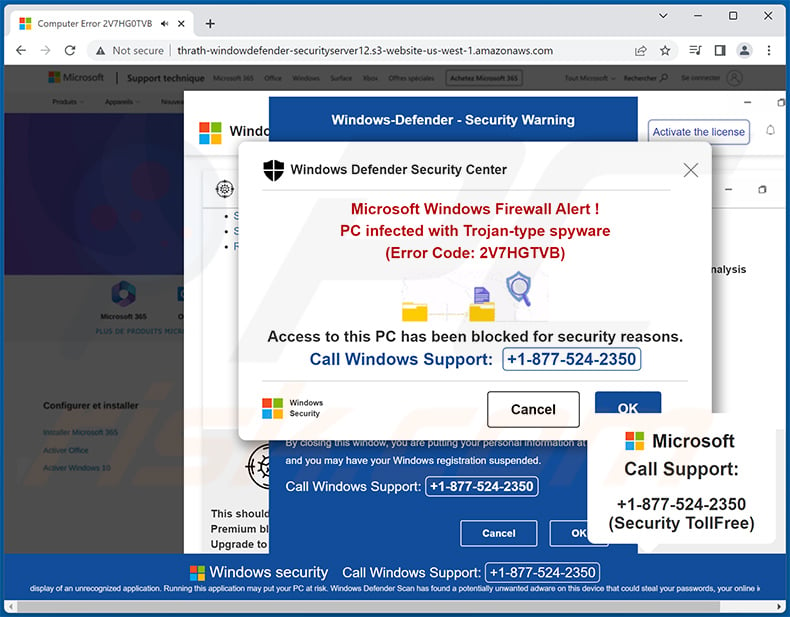Avoid getting scammed by websites displaying "Error Code: 2V7HGTVB"
Phishing/ScamAlso Known As: "Error Code: 2V7HGTVB" tech support scam
Get free scan and check if your device is infected.
Remove it nowTo use full-featured product, you have to purchase a license for Combo Cleaner. Seven days free trial available. Combo Cleaner is owned and operated by RCS LT, the parent company of PCRisk.com.
What kind of scam is "Error Code: 2V7HGTVB"?
Our researchers discovered the "Error Code: 2V7HGTVB" technical support scam while investigating suspicious sites. Presented as an alert from Microsoft Windows, this scheme claims that the user's computer has been blocked due to a detected trojan infection.
Tech support scams aim to trick victims into calling hoax support lines and allowing scammers to access their devices remotely. It must be emphasized that this scam is in no way associated with the actual Microsoft Defender Antivirus or the Microsoft Corporation.

"Error Code: 2V7HGTVB" scam overview
The webpage running "Error Code: 2V7HGTVB" is disguised as Microsoft's official website. It performs a fake system scan that detects various threats.
Multiple pop-up windows overlay the page; the one on the top states that the visitor's computer is infected by a "Trojan-type spyware" with the accompanying identification – "Error Code: 2V7HGTVB". Due to the infection, access to the device has been blocked. The user is urged to contact "Windows Support (Security Helpline)".
As mentioned in the introduction, all these claims are false, and this scam is not associated with any legitimate products, services, or companies.
Technical support scams lure victims into calling bogus helplines. Once on call, the schemes can vary. Typically, scammers request remote access (through AnyDesk, UltraViewer, TeamViewer, etc.) to the victims' computers. Throughout the process, the cyber criminals pretend to be "support" or "expert technicians" and disguise their malicious activities with technobabble.
After establishing remote access, scammers can disable/remove genuine security tools, install fake anti-viruses, obtain highly sensitive data, or infect devices with actual malware (e.g., trojans, ransomware, etc.).
Targeted information may include personally identifiable details, account log-in credentials (e.g., emails, social media, online banking, e-commerce, cryptocurrency wallets, etc.), and finance-related data (e.g., banking account details, credit card numbers, etc.).
Cyber criminals can extract the information by deceiving victims into disclosing it over the phone, typing it where it supposedly cannot be seen, or entering it into phishing websites or files. Alternatively, data-stealing malware can be used for this purpose.
It must be mentioned that the "services" of tech support scammers are expensive. Criminals prefer difficult-to-trace methods for transferring funds, e.g., cryptocurrencies, gift cards, pre-paid vouchers, or cash hidden in innocuous-looking packages and shipped. It is noteworthy that successfully scammed victims are often targeted repeatedly.
In summary, by trusting a scam like "Error Code: 2V7HGTVB" – users can experience system infections, data loss, severe privacy issues, significant financial losses, and even identity theft.
Should it be impossible to close a scam webpage, end the browser's process using the Windows Task Manager. Note that restoring the previous browsing session upon re-accessing the browser will reopen the deceptive page.
If you have allowed scammers to access your device remotely – disconnect it from the Internet and remove the remote access software used (as cyber criminals may not need your consent to reconnect). Afterward, run a full system scan with an anti-virus and remove all detected threats.
If you have disclosed your log-in credentials to scammers – immediately change the passwords of all possibly exposed accounts and inform their official support. And if you believe that your other private data has been compromised (e.g., ID card details, passport scans/photos, credit card numbers, etc.) – contact relevant authorities without delay.
| Name | "Error Code: 2V7HGTVB" tech support scam |
| Threat Type | Phishing, Scam, Social Engineering, Fraud |
| Fake Claim | User's computer is infected and has been blocked for security purposes. |
| Disguise | Microsoft |
| Tech Support Scammer Phone Number | +1-855-574-8382, +1-844-439-2968, +1-810-268-8945, +1-865-244-8728, +1(888)422-3370, +1-865-242-9260, +1-802-503-3531, 1-859-436-5000, +1-858-386-0614, +1-844-819-5036, +1-844-437-2045, +1-844-314-5702, +1-844-324-0015, +1-833-364-6684, +1-855-456-0678, +1-833-234-0299, +1-888-479-3851, +1(347)817-7442, +1-855-777-7968, +1-844-581-6203, +1-888-556-1194, +1-844-654-0384, +1-833-493-4114, +1-833-493-0997, +1-877-570-3289, +1(888)237-5047, +1-844-627-3537, +1-888-508-2753, +1-833-487-8160, +1-833-906-6648 |
| Symptoms | Fake error messages, fake system warnings, pop-up errors, hoax computer scan. |
| Distribution methods | Compromised websites, rogue online pop-up ads, potentially unwanted applications. |
| Damage | Loss of sensitive private information, monetary loss, identity theft, possible malware infections. |
| Malware Removal (Windows) |
To eliminate possible malware infections, scan your computer with legitimate antivirus software. Our security researchers recommend using Combo Cleaner. Download Combo CleanerTo use full-featured product, you have to purchase a license for Combo Cleaner. 7 days free trial available. Combo Cleaner is owned and operated by RCS LT, the parent company of PCRisk.com. |
Technical support scam examples
"Error Code:- G-0x80070057", "Clop Ransomware.dll", "!!Dridex007!! Malware Detected", "!!Rootkit!! Malware Detected", and "Virus Has Been Detected On Your Device" are just some examples of tech support scams we have investigated recently.
The Internet is rife with deceptive and malicious content. Various scam models (e.g., virus alerts, errors, outdated software warnings, giveaways, lotteries, etc.) are used to gain and subsequently abuse victims' trust.
How did I open a scam website?
Scam websites are primarily accessed via redirects generated by pages utilizing rogue advertising networks, misspelled URLs, spam browser notifications, intrusive ads, or installed adware. Online scams can also be promoted through spam, e.g., emails, PMs/DMs, SMSes, forum posts, compromised social media accounts, etc.
How to avoid visiting scam websites?
Due to how widespread deceptive and malicious content is on the Web – we strongly recommend exercising caution while browsing. We advise against using sites that offer pirated software/media or other questionable services (e.g., Torrenting, illegal streaming/downloading, etc.), as these websites typically use rogue advertising networks.
It is important to pay attention to URLs and enter them with care. To avoid receiving unwanted browser notifications – do not permit dubious webpages to deliver them (i.e., do not click "Allow", "Allow Notifications", etc.). Instead, ignore or deny notification requests from such sites (i.e., select "Block", "Block Notifications", etc.).
To avoid allowing bundled/harmful programs to infiltrate the system – we advise downloading only from official and verified sources. Additionally, installation must be treated with care, e.g., by reading terms, exploring possible options, using the "Custom/Advanced" settings, and opting out of all supplementary apps, extensions, tools, and so forth.
If your computer is already infected, we recommend running a scan with Combo Cleaner Antivirus for Windows to automatically eliminate all threats.
Text presented in "Error Code: 2V7HGTVB" scam topmost pop-up:
Windows Defender Security Center
Microsoft Windows Firewall Alert !
PC infected with Trojan-type spyware
(Error Code: 2V7HGTVB)
Access to this PC has been blocked for security reasons.
Contact Windows Support: +1-844-437-2045 (Security Helpline)
Microsoft [Deny] [Allow]
The appearance of "Error Code: 2V7HGTVB" pop-up scam (GIF):

Another appearance of "Error Code: 2V7HGTVB" pop-up scam:

Instant automatic malware removal:
Manual threat removal might be a lengthy and complicated process that requires advanced IT skills. Combo Cleaner is a professional automatic malware removal tool that is recommended to get rid of malware. Download it by clicking the button below:
DOWNLOAD Combo CleanerBy downloading any software listed on this website you agree to our Privacy Policy and Terms of Use. To use full-featured product, you have to purchase a license for Combo Cleaner. 7 days free trial available. Combo Cleaner is owned and operated by RCS LT, the parent company of PCRisk.com.
Quick menu:
- What is "Error Code: 2V7HGTVB" tech support scam?
- How to identify a pop-up scam?
- How do pop-up scams work?
- How to remove fake pop-ups?
- How to prevent fake pop-ups?
- What to do if you fell for a pop-up scam?
How to identify a pop-up scam?
Pop-up windows with various fake messages are a common type of lures cybercriminals use. They collect sensitive personal data, trick Internet users into calling fake tech support numbers, subscribe to useless online services, invest in shady cryptocurrency schemes, etc.
While in the majority of cases these pop-ups don't infect users' devices with malware, they can cause direct monetary loss or could result in identity theft.
Cybercriminals strive to create their rogue pop-up windows to look trustworthy, however, scams typically have the following characteristics:
- Spelling mistakes and non-professional images - Closely inspect the information displayed in a pop-up. Spelling mistakes and unprofessional images could be a sign of a scam.
- Sense of urgency - Countdown timer with a couple of minutes on it, asking you to enter your personal information or subscribe to some online service.
- Statements that you won something - If you haven't participated in a lottery, online competition, etc., and you see a pop-up window stating that you won.
- Computer or mobile device scan - A pop-up window that scans your device and informs of detected issues - is undoubtedly a scam; webpages cannot perform such actions.
- Exclusivity - Pop-up windows stating that only you are given secret access to a financial scheme that can quickly make you rich.
Example of a pop-up scam:

How do pop-up scams work?
Cybercriminals and deceptive marketers usually use various advertising networks, search engine poisoning techniques, and shady websites to generate traffic to their pop-ups. Users land on their online lures after clicking on fake download buttons, using a torrent website, or simply clicking on an Internet search engine result.
Based on users' location and device information, they are presented with a scam pop-up. Lures presented in such pop-ups range from get-rich-quick schemes to fake virus scans.
How to remove fake pop-ups?
In most cases, pop-up scams do not infect users' devices with malware. If you encountered a scam pop-up, simply closing it should be enough. In some cases scam, pop-ups may be hard to close; in such cases - close your Internet browser and restart it.
In extremely rare cases, you might need to reset your Internet browser. For this, use our instructions explaining how to reset Internet browser settings.
How to prevent fake pop-ups?
To prevent seeing pop-up scams, you should visit only reputable websites. Torrent, Crack, free online movie streaming, YouTube video download, and other websites of similar reputation commonly redirect Internet users to pop-up scams.
To minimize the risk of encountering pop-up scams, you should keep your Internet browsers up-to-date and use reputable anti-malware application. For this purpose, we recommend Combo Cleaner Antivirus for Windows.
What to do if you fell for a pop-up scam?
This depends on the type of scam that you fell for. Most commonly, pop-up scams try to trick users into sending money, giving away personal information, or giving access to one's device.
- If you sent money to scammers: You should contact your financial institution and explain that you were scammed. If informed promptly, there's a chance to get your money back.
- If you gave away your personal information: You should change your passwords and enable two-factor authentication in all online services that you use. Visit Federal Trade Commission to report identity theft and get personalized recovery steps.
- If you let scammers connect to your device: You should scan your computer with reputable anti-malware (we recommend Combo Cleaner Antivirus for Windows) - cyber criminals could have planted trojans, keyloggers, and other malware, don't use your computer until removing possible threats.
- Help other Internet users: report Internet scams to Federal Trade Commission.
Frequently Asked Questions (FAQ)
What is a pop-up scam?
Pop-up scams are deceptive messages intended to deceive users into performing specific actions. For example, victims can be tricked into calling fake support lines, allowing cyber criminals to access devices remotely, making monetary transactions, disclosing vulnerable data, downloading/installing software, purchasing products, subscribing to services, etc.
What is the purpose of a pop-up scam?
Pop-up scams are designed to generate revenue. Scammers primarily profit by obtaining funds through deception, abusing or selling private information, promoting content, and proliferating malware.
Why do I encounter fake pop-ups?
Pop-up scams are promoted on deceptive websites. They are most commonly accessed via redirects caused by sites using rogue advertising networks, mistyped URLs, intrusive ads, spam browser notifications, or installed adware.
I cannot exit a scam page, how do I close it?
If you cannot exit a scam page, you must terminate the browser's process using Task Manager. However, keep in mind that when the browser is relaunched – the previous browsing sessions must not be restored, as that would reopen the deceptive webpage.
I have allowed cyber criminals to remotely access my computer, what should I do?
If you have allowed cyber criminals to access your computer remotely – first disconnect it from the Internet. Second, remove the remote access program that the criminals used (e.g., UltraViewer, TeamViewer, AnyDesk, etc.). Last, perform a complete system scan with an anti-virus and eliminate all detected threats.
I have provided my personal information when tricked by a pop-up scam, what should I do?
If you have provided your log-in credentials – change the passwords of all possibly compromised accounts and inform their official support without delay. And if you've disclosed other private data (e.g., ID card details, passport scans/photos, credit card numbers, etc.) – immediately contact the appropriate authorities.
Will Combo Cleaner protect me from pop-up scams and the malware they proliferate?
Combo Cleaner is designed to eliminate all manner of threats. It can scan visited websites and detect scam and malicious ones. It can also deny all further access to these pages. Furthermore, Combo Cleaner can scan computers, detect and remove nearly all known malware infections. Note that since high-end malicious software tends to hide deep within systems – running a full system scan is essential.
Share:

Tomas Meskauskas
Expert security researcher, professional malware analyst
I am passionate about computer security and technology. I have an experience of over 10 years working in various companies related to computer technical issue solving and Internet security. I have been working as an author and editor for pcrisk.com since 2010. Follow me on Twitter and LinkedIn to stay informed about the latest online security threats.
PCrisk security portal is brought by a company RCS LT.
Joined forces of security researchers help educate computer users about the latest online security threats. More information about the company RCS LT.
Our malware removal guides are free. However, if you want to support us you can send us a donation.
DonatePCrisk security portal is brought by a company RCS LT.
Joined forces of security researchers help educate computer users about the latest online security threats. More information about the company RCS LT.
Our malware removal guides are free. However, if you want to support us you can send us a donation.
Donate
▼ Show Discussion